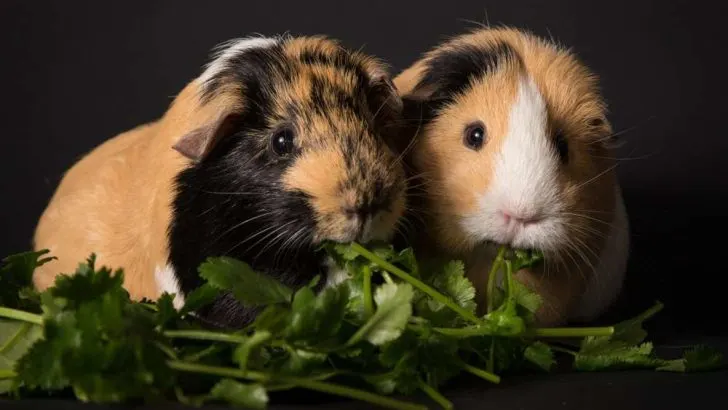Finding out what guinea pigs can eat can be rather time-consuming, especially if this is your first one. Luckily, we know all about it and we are happy to help you out!
Continue reading to find out all about guinea pigs and their diet!
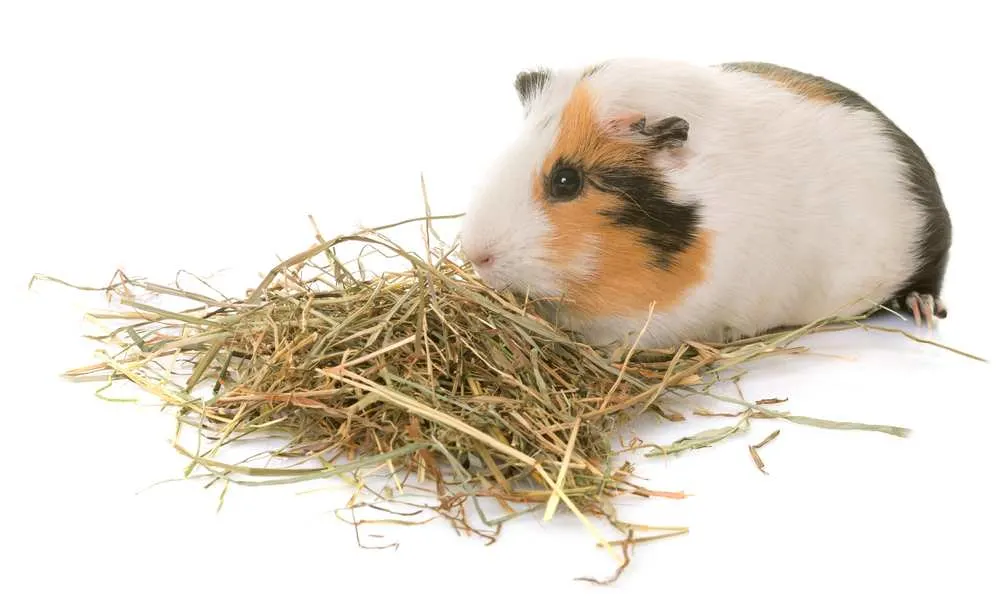
What Can Guinea Pigs Eat?
Well, there are a lot of things guinea pigs can eat. Let’s start with the most important food items – like hay. Hay is a must-have in your guinea pig’s diet because they need the fiber to digest food properly.
The hay also helps your pet’s teeth wear down, which grow continuously throughout their life. The kay should be fresh, dry, sweet-smelling, and mold-free!
The hay should be available to your pet at all times because it’s necessary for your pet. Make sure that the hay is in a hayrack or basket – and never on the enclosure floor, as it could be easily contaminated on the floor and make your guinea pig sick.
Furthermore, pellets – the commercial guinea pig food is formulated to give the pigs perfectly balanced-out meals. Pick a quality pelleted food for your pet – one that has been approved by veterinarians and approved.
Of course, guinea pigs can eat vegetables – and vegetables make an essential part of their diet. When you do pick out some veggies, you have to introduce them to the guinea’s diet. Also, keep in mind that fresh, organic, locally-grown veggies are the best option for your furry baby.
Fruits are also something that can find their way into your pet’s tummy. Fruits can be healthy and great for your piggie – but we will talk more about which fruits are the best for them.
Now, we will talk about the food dosage and the exact food items safe for your guinea pig. Continue reading to find out all about it!

Commercial Food & Hay
Commercial food for your guinea pig may be the best option there is. The commercial food pellets are already balanced out and full of necessary vitamins and minerals.
The pelleted food already comes with an extensive guide on dosage, so you don’t have to worry much about the amount you’re supposed to give the pet. Just check out the guide on the back of the bag, and you’re good to go!
As for the commercial food, there is something else we wanted to discuss with you as well – cecotropes. The guinea pigs’ nutritional needs are unusual, as well as the methods for supplementing their diet.
So, cecotropes are soft, rather small pellets with nutrients absorbed from the plants during the process of digestion. The pellets pass through the whole digestive system – and they are consumed immediately.
This whole process of supplementing your guinea pig’s diet may seem utterly bizarre, we agree. Still, you should never discourage it because the cecotropes are essential in your pet’s diet and they give your pet many required nutrients!
Moreover, hay is utterly essential for guinea pigs – and the best option is the Timothy hay. Other good hay is Oaten, Parley, and grassy. The hay is needed to provide the pet with a complete diet, and it encourages the pigs to chew for a long time.
As we already said – the pigs’ teeth grow continuously and chewing the hay wears them out. Make sure that your pets always have fresh hay on hand!
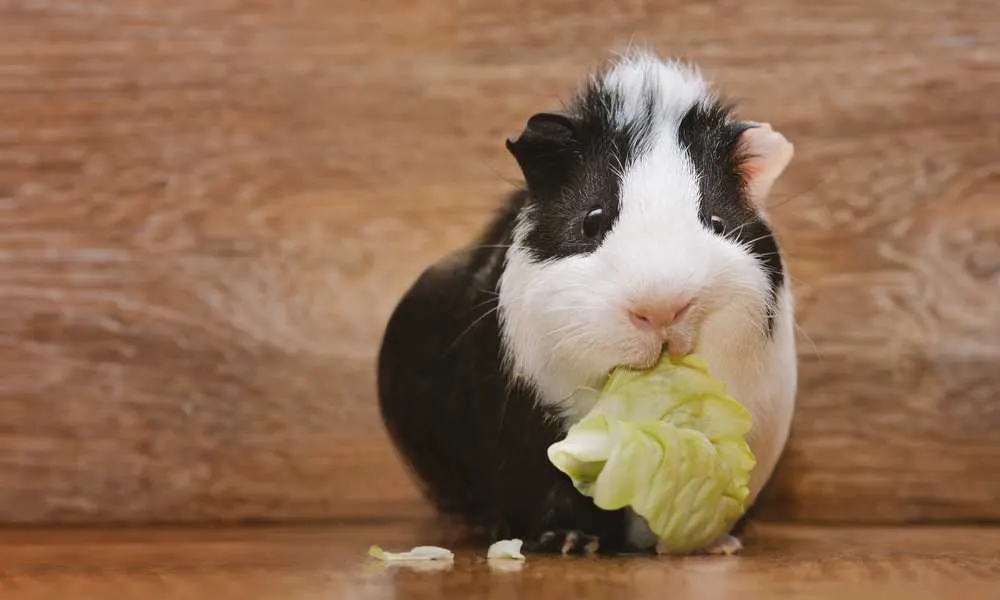
Guinea Pigs & Vegetables
Guinea pigs love eating vegetables and what’s more, the vegetables are great for them. However, you shouldn’t feed them too much.
Remember: one cup of vegetables a day is more than enough. Guinea pigs are tiny and they don’t need too much food – too much can give them tummy woes.
The piggie should be offered a variety of different vegetables in the meal – especially leafy greens and herbs. So, raspberry leaf, lettuce, lettuce romaine, radicchio, rocket, dandelion greens, and similar leafy greens can be given daily.
Also, herbs like borage, marigold, rosemary, parsley, basil, coriander, dill, and nasturtium as well can make the tastiest veggie meal for your guinea pig. These herbs are easily digestible, so they can eat them almost every day.
Some cruciferous veggies like Brussels sprouts, broccoli, cabbage, and arugula are fine on a few-times-per-week basis. Anything more than that could cause some indigestion. Read More: Can Guinea Pigs Eat Napa Cabbage?
Your guinea pig could love carrots and carrot tops, kale, mint, squash, endive, and bell pepper. Make sure that you introduce the food before you add it to your pet’s meal. Look at their response and try to conclude whether they like it or not.
Also, bell peppers, just like the leafy greens can make a yummy but essential part of your pet’s diet. These veggies are full of vitamin C, which is very important in their diet!
See Also: Can Guinea Pigs Eat Sprouts?; Can Guinea Pigs Eat Bean Sprouts?

Guinea Pigs & Fruits
Fruits are perfectly safe for your guinea pig, as we previously discussed. However, you should aim to give your pet more veggies than fruits. The reason behind that is that fruits have more sugar than veggies, and too much sugar is not good for guinea pigs.
So, the moderate amount of fruits are yummy in their tummy. The best fruits for guinea pigs are apples – with the seeds removed, pears, papaya, kiwi, blueberries, strawberries, peaches, and oranges.
Besides the limited amount of fruits in their diet, do remember to introduce each fruit before you start giving it to them on the regular. Also, make sure that the fruits you are planning to give them are safe for your piggie.
The list of banned foods or guinea pigs is rather extensive. Feeding your guinea pigs with something they shouldn’t eat doesn’t result only in mild discomfort. It could do your pig some serious harm, even kill them!

What Food Guinea Pigs Shouldn’t Eat?
Just like the list of a-okay foods for guinea pigs, the list of foods they should avoid is extensive as well. You will need to remember or write down everything your furry baby shouldn’t eat and stick to it.
Each animal has something they need to avoid – and guinea pigs are no different. Here, we will discuss everything you need to keep an eye on for your pet!
First up, we will discuss the general things about foods your guinea pig should never, ever eat. Number one is meat!
Guinea pigs don’t have any health benefits if they do eat meat. What’s more, even the smallest amount of meat could be dangerous for them because guinea pigs cannot process meat protein properly.
The next one up is chocolate. Chocolate has no benefits for your dear pet, and it could even be dangerous for them to eat chocolate. Also, any other food item containing caffeine should be kept far, far away from guinea pigs.
Common food items like bread and dairy are a no-go, as well. A general rule of thumb is that guinea pigs are herbivores, meaning their diet benefits only from fruits and veggies.
Meat and meat products, as well as processed foods, are rather dangerous for your dear baby. So, no peanut butter – even if it’s technically made from plants!
It may seem like every type of hay is perfect and yummy for guinea pigs – because you can see them chewing on it all the time. However, that is not entirely true – there are some types of hay they should avoid.
Those types would be Lucerne and Clover hay. These types of hay are unsuitable because they are too high in protein and calcium, making them difficult to digest.

What Veggies Should Guinea Pigs Avoid?
Of course, we have discussed the general things, but now it’s time to cover the vegetables. Most veggies are perfectly fine, even great for guinea pigs, but there are some you need to avoid at all times.
For example, most cruciferous vegetables are safe, even very healthy for guinea pigs. That is not the case with bok choy, which could be too hard on your pet’s tummy.
Other notable veggies to avoid are onions and garlic, and corn kernels. Onions and garlic are very acidic so your pet cannot process them well, and it could choke on a kernel. This is precisely the reason why you should remove seeds from any veggie you give to it.
Moreover, all kinds of seeds and nuts are a no-go, because the guinea pig could choke on them. If it’s kind of small, the pet could try to swallow it whole and choke.
Almost every type of lettuce is perfect for your guinea pig because leafy greens provide the pigs with the vitamin C they need. That is, however, not the case with iceberg lettuce and rhubarb, which can be too hard for them.
Mushrooms are technically not veggies, but they are often prepared and eaten with veggies. They should be avoided as well as potatoes. Potatoes are full of sugar, which is no good for your tiny furry friends!

Fruits Your Guinea Pig Should Not Eat
Just like veggies, there are some fruits your guinea pig needs to avoid, too. However, the list of fruits that have to be avoided is more extensive.
The reason behind that is that fruits have more sugar in them, and sugars either have no benefits to the pig’s health, or they are straight-up unhealthy. So, the first note is that the number of fruits should be significantly smaller than the number of veggies.
Keep in mind that even if some fruits are safe for your guinea pig, that doesn’t mean it should eat only fruits. For example, strawberries are yummy and safe, but they are very sweet and full of sugars, so they are not the greatest idea of all time.
Moreover, tomatoes should be avoided altogether, always. The truth is – tomatoes aren’t dangerous generally, but the stems are poisonous for guinea pigs, even in the smallest amounts. Even if you clean the tomato and remove the stem carefully, you can never truly be sure. Best to avoid it, then!
Mandarins and tangerines are safe, but they should be fed in very, very limited amounts. That’s the general rule with all the fruits we haven’t marked in the section above.

Can Guinea Pigs Eat Dried Fruit?
Sure, most fruits are safe for guinea pigs, apart from a few things. So, is dried fruit the same?
Well, your guinea pig will not be harmed by eating a little dried fruit from time to time, that is the truth. However, the guinea pigs shouldn’t eat dried fruit, even if it’s safe.
The dried fruit is much denser than the fresh variety, meaning it’s high in calories, as well as sugar. As we mentioned above, sugars are not the best for rodents like guinea pigs.
Of course, a small quantity from time to time will not harm your pet or anything. You can give them a teeny tiny amount for special occasions, but that’s it. No more than that!
If you do decide to use the dried fruit for special moments, make sure to use organic dried fruit, without any preservatives added. Keep in mind that guinea pigs adore fresh fruit and enjoy eating it as-is. There is truly no need to introduce dry fruit to their diet!
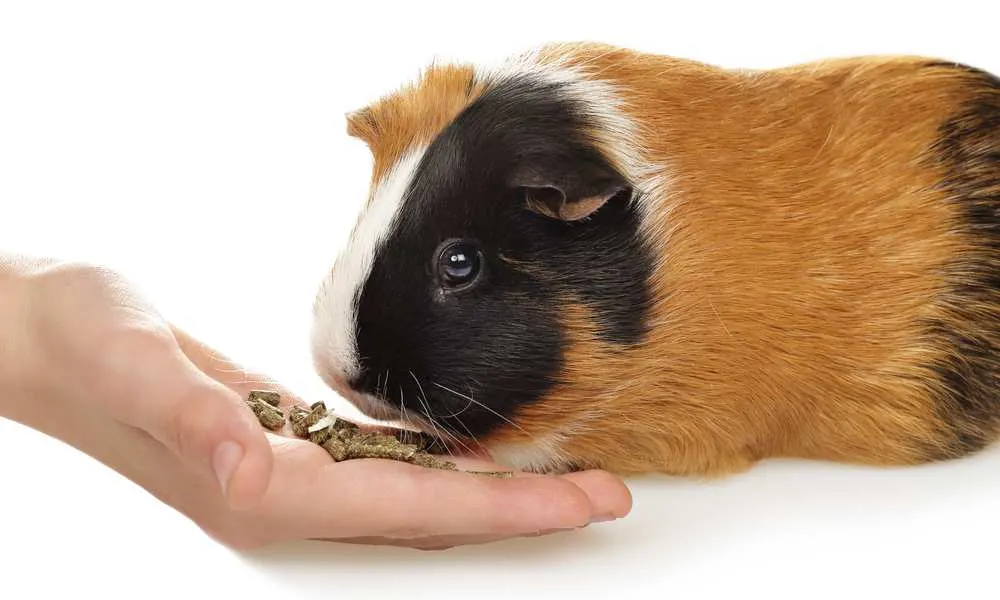
Feeding Your Guinea Pig
For those who have their first guinea pigs, there are a lot of things you need to get acquainted with. Feeding your pet is just one of them, and there are many rules you will need to follow about feeding.
Since hay is so important – it should always be on hand for your pet. Make sure that you top it up in the basket twice a day. Doing it in the morning and evening might be best, but you can pick any time of the day that works best for your schedule.
Make sure that your guinea pig has fresh water at all times, too. It may seem like they don’t drink much water, but they do need to stay hydrated to live a long and healthy life.
Also, keep in mind that you should have dedicated baskets for hay, as well as other food items – be that pellet, fruits, or veggies. You shouldn’t place it on the floor, because food could get contaminated and give your pet some annoying disease.
The commercial food pellets are perfect for guinea pigs. They provide the rodents with a balanced-out meal, full of vitamins and minerals they need. Commercial food has the ideal balance of carbs and protein, so you don’t have to think much about that.
The label on the back of the food bag has all the info you might need about the dosage. The label will say that the food should be topped up once a day, but you can split that in two if you prefer to feed your pet twice a day.
Either way, don’t let the food run out. If you are worried you will stay out late, it’s better to give the guinea pig a bit more food to make sure they aren’t hungry, rather than letting them starve until you make your way back home.

Introducing New Food Items
Food pellets or hay is something your guinea pig is used to, so there is truly no need to introduce a new type of hay. Guinea pigs have eaten hay for all their lives, so it’s nothing new. Even if you try a new commercial brand of food, there is no need to introduce it.
Perhaps, you can watch your pet closely after you start giving them a new food brand, but that’s it. That food is prepared specially for guinea pigs, and they should have no issues digesting it.
On the other hand, that is not the case with vegetables and fruits. Sure, vegetables have to be a principal part of your rodent’s diet, but they still need to get used to that food item, nonetheless.
Introducing a new food item is a process – it starts by giving your pet a tiny bit of the new food. Then, you start increasing the dosage until you reach the full allowed portion.
For guinea pigs, the full portion is one cup of veggies, and as for fruits – 1 cherry, one small slice of apple, and so on. The goal is to get your pet’s tummy used to the new food and to prevent them from becoming opposed to it just because it’s new.
Moreover, guinea pigs are more sensitive to foods that humans have no issues digesting. Loads of sugar, protein, or calcium can be too much for their metabolism and it could do them serious harm. That’s why introducing the new food is essential!

Preparing Fruits & Veggies
When you prepare food, there are things you need to keep in mind. The number one rule is to cut up everything into tiny bits. Chop everything into bite-size pieces – but bite-size of a guinea pig, not a human!
If it’s too large, the guinea pig could try to swallow the piece whole, and start choking. The next rule is to remove any seeds, stems, and hard shells if there are any.
Nuts and seeds should be avoided, yes, but apples have seeds too. Remove everything undesirable carefully and serve the guinea pig a proper amount.
The general rule of thumb for veggies is 1 cup of veggies, once per day. For fruits, it’s much, much less. The easiest way to remember how much fruit your guinea pig eats is one cherry.
One whole cherry – without the stem or seed, is more than plenty for your furry friend. Use the size of the cherry as your guide for other fruit, especially larger ones. Guinea pigs love raspberries, so they could probably get away with eating even two at a time!
Veggies are perfectly safe to eat every day, but the story is not the same with the fruit. Fruit should be eaten once, twice a week at the most. Too much fruit is highly unhealthy for your guinea pig!
What’s more, everything you want to give your pet should be thoroughly washed, cleaned, and properly prepared. Clean the fruit and veggies the same way you would clean them for your family.
Also, try to find organic, locally-grown produce that is free of any pesticides. Humans can process pesticides without any harm, but guinea pigs are much smaller and the same amount could at least give them some tummy woes, or worse, food poisoning.
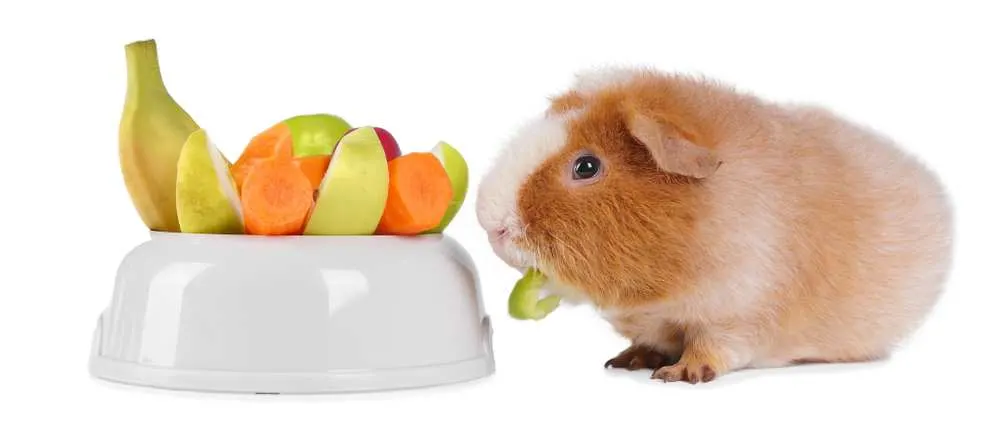
Diet-Related Health Issues In Guinea Pigs
Humans can experience various health issues because they have a poor diet. The same thing is with animals – and their life span can significantly be shortened because of a poor diet.
As the owner, it’s your responsibility to give your guinea pig the diet it needs. If you decide to go with commercial food – you cannot go wrong because it’s perfectly balanced out to give the rodent all the nutrients it requires.
So, let’s check out what are diet-related health issues guinea pigs can have below!
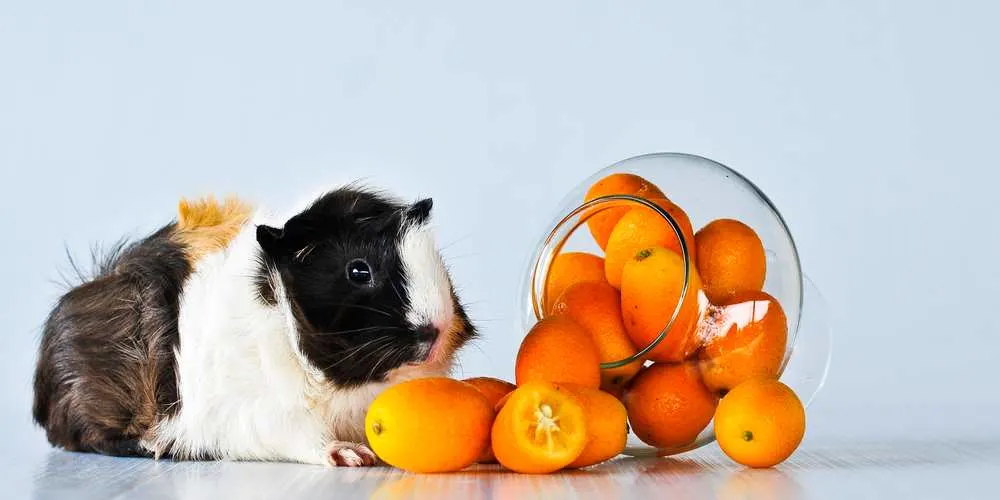
Vitamin C Insufficiency
Vitamin C, also known as ascorbic acid, is one of the most essential vitamins in all animals – as well as humans. Vitamin C aids in tissue repairs, and scurvy prevention. Scurvy is a disease that usually happens due to vitamin C insufficiency.
Vitamin C is a key vitamin for maintaining a good immune system. So, many animals produce the vitamin C they need – all on their own. Unfortunately, guinea pigs are not one of those animals.
Because of that, it’s necessary to supplement guinea pig’s diet to boost them with plenty of vitamin C. That way, the guinea pig will be fit, healthy, and able to fight off diseases.
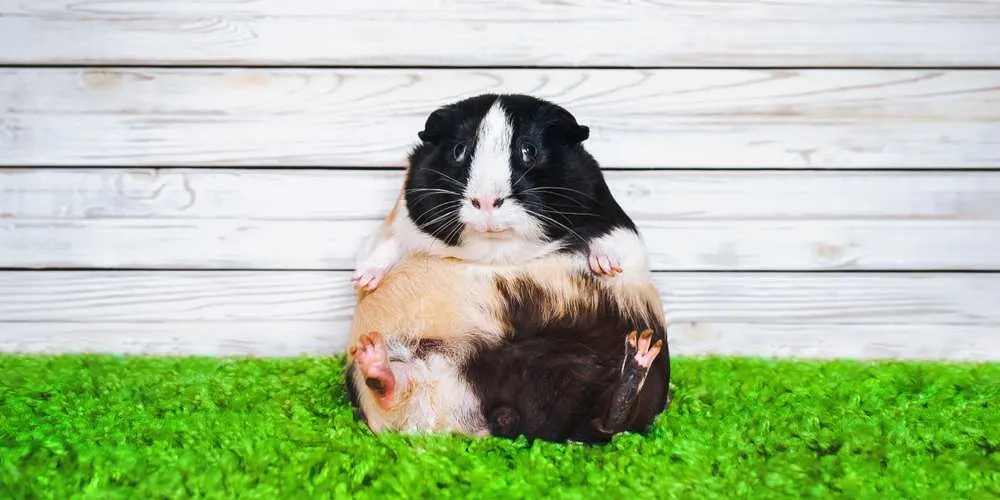
Weight Issues
It’s no lie – guinea pigs love to eat. You can almost always see your pet chewing away some hay or going to the corner to eat pellets. They love to eat all the time. That may be cute, but your guinea pig could easily become obese, without you even realizing it on time.
If you are worried your guinea pig is gaining weight, consult your vet on the next steps you should take. Watch their food intake closely and never give too much food to your guinea pigs, even if they seem to devour everything you give them. The reality is, they are probably just gluttonous!

Urinary Tract Infections
Guinea pigs are rather prone to developing urinary tract infections, also known as UTIs. The main cause for UTIs in guinea pigs is too much calcium in their diet.
The second, rather common cause is an infection because their genitals are close to the cage floor. If the cage floor is dirty, it can be a haven for various strains of bacteria.
There are a few symptoms that can tell you whether your guinea pig has a UTI. The first one is painful urination, which you can spot if you can hear your guinea pig squeaking or squealing when peeing. Other symptoms are blood in urine and frequent urination.
Preventing a UTI is the best course of action – and to prevent it, you should avoid giving your pet any food that is high in calcium (as listed above), give your pet lots of water, and keep the cage clean at all times. However, if the UTI still appears, consult your vet.
A round of antibiotics will clear up any infection. Also, some extra supplements of vitamin C will help your pet fight off the infection.

Bladder Stones
Guinea pigs are prone to getting bladder stones, as well. The symptoms of bladder stones are similar to symptoms of urinary tract infections.
The most common symptoms of bladder stones are frequent urination and straining to urinate. Also, look for blood in urine, or red patches on the bottom.
If the bladder stone starts to advance, you can spot lethargy, and the guinea pig may appear hunched. Unfortunately, your pet will likely require surgery to remove the bladder stone because they are usually too large to be passed through the urinary tract. If you’re worried that your guinea pig might have a bladder stone, consult your vet at your earliest convenience!
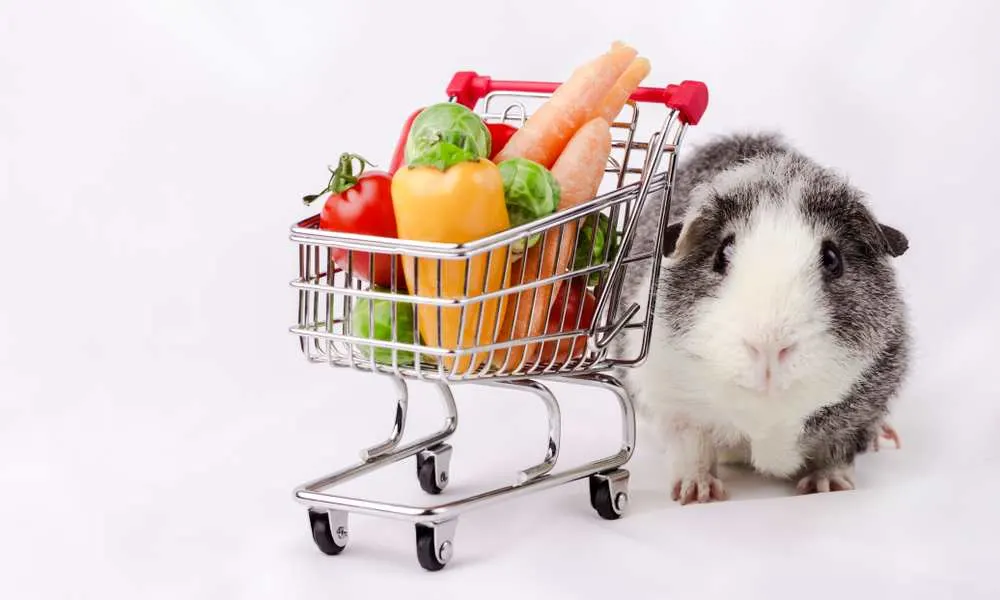
Bottom Line
To conclude, guinea pigs can eat a lot of things. However, they need a rather simple diet to keep them happy and healthy. Keeping a basket full of hay, plenty of water and some pellets is more than enough!
Guinea pigs love eating veggies, as well as fruits. In reality, there are so many veggies and fruits they can eat safely, and you should take your time to prepare those items properly. Introducing a new food item works like a charm!
Also, a modest amount of fruits can prevent vitamin C insufficiency and other diseases. If that wasn’t wonderful enough – guinea pigs find fruit delicious!

